For those of us trapped along the equator or in the southern hemisphere, skiing may seem like a niche sport. It hasn’t been around for as long as rugby or football, nor does it feature the intricacies of either.
However, as you’ll find in this article, skiing is so much more than simply racing down a slope with a pair of metal strips attached to your feet. There are different styles and techniques, all of which have their own nuances and best approaches.

In this article, we’re going to shed some light on the many different types of skiing, with explanations for each that will hopefully provide you with a greater understanding – and appreciation – of this fun winter sport.
We will therefore dive deeper into the following types and “subtypes” of skiing:
| Type | Subtypes |
| Alpine | Normal Skiing |
| Carving | |
| Race Skiing | |
| Off-Piste or Free-Skiing | Off-Piste |
| Freeriding | |
| Backcountry / Touring | |
| Ski Mountaineering | |
| Freestyle | |
| Nordic Skiing | Telemark |
| Cross-Country |
Alpine Skiing: the initial and most common type of skiing
Alpine skiing is perhaps the most common form of skiing, and the one most non-skiers will be familiar with. It involves skiing down snow-covered hills and was first developed by the British in the late 1800s and early 1900s in the French Alps, from which it derives its name.
Being the most popular form of skiing, you would be forgiven for thinking that Alpine skiing lacks any remarkable, easily-identifiable features.
These days, alpine skiing in resorts takes place on marked and groomed slopes specially designed to facilitate this type of skiing. In the last 20 – 25 years, the material used on the skis themselves has changed. While the skis were previously up to 2m long, narrow and straight cut, the design changed significantly due to the emerging Carvin Skis. Thus, the length of today’s skis is shorter, and all types of skis have more or less waist, which makes them much easier and more comfortable to ride.
But why was there suddenly so much movement in ski development?
By the start of the early 2000s, skiing was put under a lot of pressure by the upcoming sport of snowboarding. In response, the skiing industry worked on some significant design changes for skis – carving was introduced that was specific to shorter skis, with a much more prominent waist on the skis. This would allow the skier to make more radical turns ridden entirely on the ski edge, giving skiing a more dynamic feel.
Over time, the industry would once again begin producing skis that are slightly longer than fully-fletched carving skis, but were still based on the original principle. Today, these alpine skis are used on slopes that have a length of around chin height, as well as some wasting.
Despite being the most common and instantly-recognizable form of skiing, Alpine skiing encompasses a range of different subtypes. The three primary subtypes are standard Alpine skiing, carving, and race skiing. Each of them requires a different approach or set of techniques to perform well. However, they all take place on well-groomed slopes, and skiers are not allowed to leave the demarcated area.
Normal Skiing
Normal Alpine skiing involves everything we’ve already discussed. Skiers make use of standard piste skis on groomed slopes.
Carving
Carving involves the use of specialized skis, which have a wider tip and tail, but are much smaller underneath the bindings. They’re generally shorter, too, giving the skis a more “extreme” shape. Also, they are less stiff than “normal” Alpine skis, but still provide a high torsional stiffness. Carving skis have a much smaller turning radius and allow for short, hard turns and the skier can reach an extreme sloping position.
Example picture:
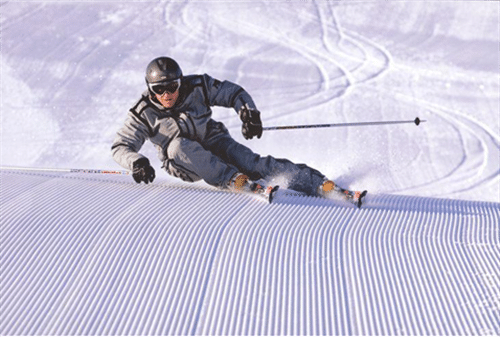
In terms of technique, the primary goal of carving is to make sharp turns as much as possible. This is aided by the shape of carving skis and is what distinguishes this style from normal Alpine skiing.
Race Skiing
True to its name, race skiing involves racing along a set course, downhill, and on a groomed slope. The techniques involved will largely depend on the type of race being held. Slalom involves short skis through tight and fast turns, while Super G and Downhill involve much longer turns and long gliding passages with speeds of up to 140km/h down the mountain.
The main distinguishing feature of race skiing is the presence of the racecourse itself, which restricts where skiers may go. Furthermore, race skis differ in their shape depending on the discipline: slalom skis are short, allowing for tight, fast turns, whereas downhill skis are long and allow for more float, giving them stability at high speeds.
The most important difference between a race ski and a normal ski is that the race ski is much stiffer and harder. This allows more performance, but requires corresponding strength and technique.
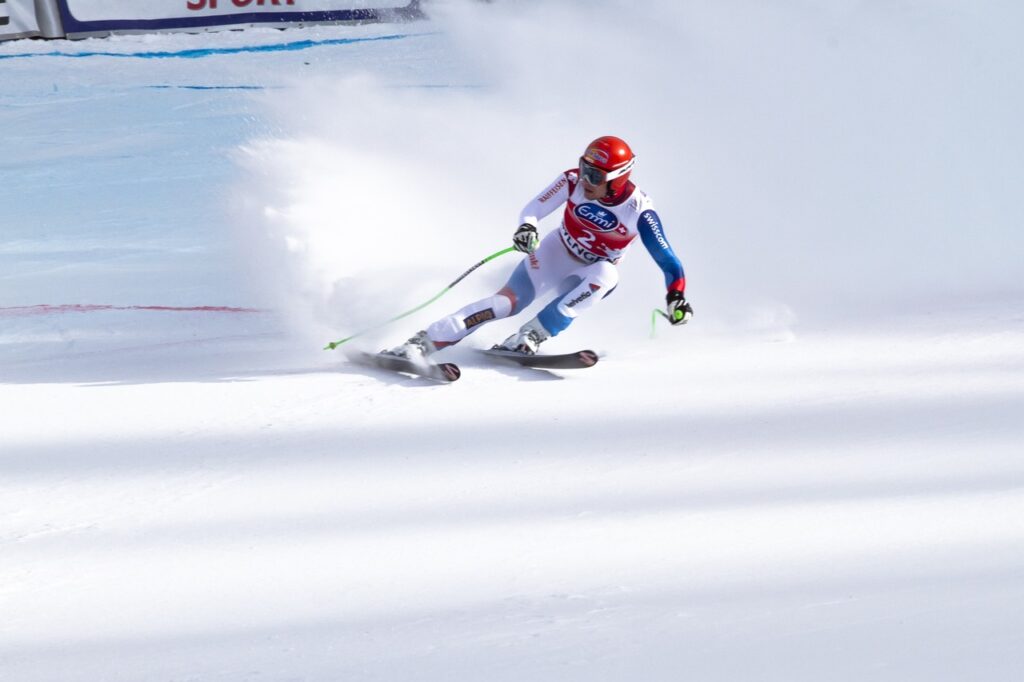
Off-Piste or Free-Skiing: the most thrilling types of skiing
By now, it should be abundantly clear that skiing is a much more elaborate sport than it may seem at first glance, and it only gets more extensive from here.
Off-piste or free-skiing is similar to Alpine skiing in that it involves skiing downhill, but that’s where the similarities end. You see, while Alpine skiing restricts skiers from leaving the demarcated areas, free-skiing is intended for ungroomed terrain. Because of this, free-skiing demands more skill from those who would undertake it.
Additionally, if you want to try your hand at off-piste skiing (also called backcountry skiing), be prepared to shell out for a few extra pieces of equipment. The more varied terrain forces you to adapt your equipment as well.
Lastly, before we take a look at the different types of free-skiing, be warned that – while exhilarating – free-skiing brings a few additional risks with it, since you are moving in high mountain areas. You’ll need to undertake a fair bit of training before you can brave the untamed slopes, and even then, it’s best that you ski in a group to ensure everyone’s safety.
Off-Piste and free-riding skis are wider and longer compared to Alpine skis. Skis for Touring and Mountaineering are wider, but much lighter as you walk, hike, or backpack with the skis on your feet. Touring or Mountaineering skis also use different bindings, which allow you to free the back of your shoe from the ski to make walking more comfortable.
Pure freestyle skis, on the other hand, are slightly less wide and tend to be shorter than skis for powder skiing, but must have clearer twin tips (i.e. skis that are bent up at the front and back) to make it easier to reverse and land. In general, though, the distinctions are blurring a bit here as more and more freestyle elements are being incorporated into freeriding. And besides, twin tip skis simply give a cooler spray when powdering.
Below, we’ll look at off-piste, freeride, and backcountry/touring, which mainly differ by how far from the marked slopes you go into the powder and how far you’ll walk. Then we’ll dive into Mountaineering, which also includes some climbing, and freestyle, which focuses on jumping and tricks.
Off-Piste Skiing
While the terms off-piste, freeriding, and backcountry skiing are often used interchangeably, there are a few subtle yet notable differences between them. Off-piste skiing still takes place in the larger area of ski resorts, but is done outside the marked and groomed slopes. So we understand Off-Piste mainly when you leave the groomed slopes, but you only undertake a shorter ride in the powder snow and return back on a groomed slope.
The best ski type for off-piste skiing are all-mountain skis. They are wider and generate more uplift than normal alpine skis, but work better on groomed slopes than ultra-wide, pure powder skis.
Freeriding
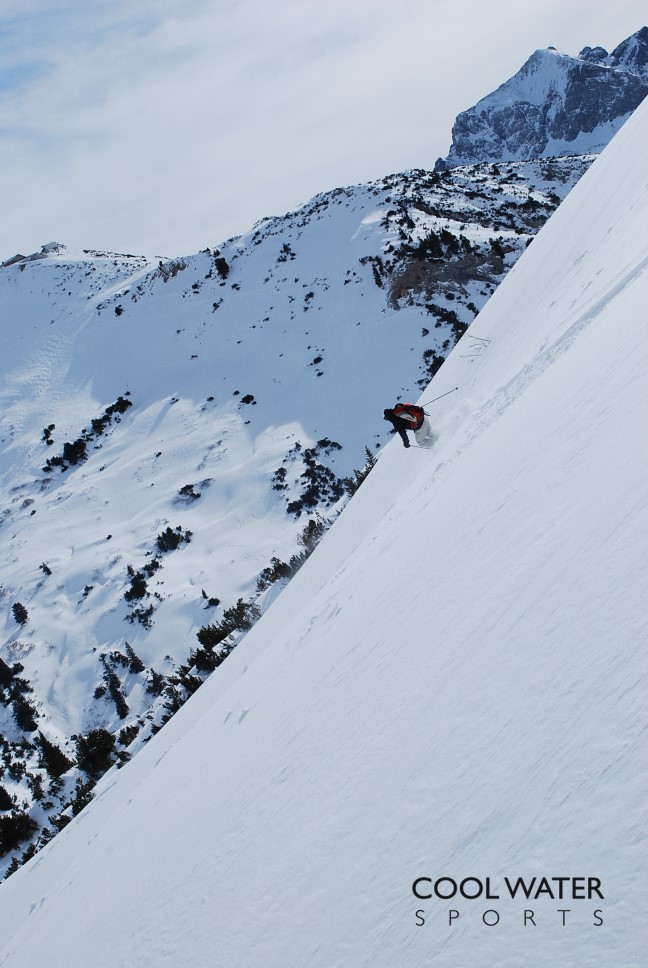
Freeriding or Powder Skiing takes place on completely natural, untamed terrain. There are no goals and no courses – just the thrill of the descent.
As a differentiation from off-piste, a freeride adventure typically starts at the top of a ski lift, chairlift, or gondola, but doesn’t necessarily end at the bottom station – it could lead you into another valley or directly into the village. A short hike can be part of freeriding, but is not a main part of the fun. A freerider only hikes up when he will be rewarded with a longer descent. That’s the main difference between freeriding and touring or backcountry skiing.
Freeriding requires plenty of skill (and equipment) in order to master. You’ll encounter various types of terrain, from steep slopes to short descents, in various conditions, and you’ll need enough training to come out unscathed.
As a summary: the main difference between freeriding and off-piste skiing is that the former can involve a short hike to the top of the slope and that you leave the controlled ski area.
The best ski type to ride deep powder is definitely powder skis or fat skis. These skis are wide, have low stiffness and lots of rocker. This provides maximum lift in powder, but makes the skis a little harder to control on a hard, groomed slope. They are the best option if you decide to spend most of your time in powder snow. However, if you want a more versatile ski that still works great in deep, fluffy snow, then all-mountain skis would be the better choice.
Backcountry/Touring
Backcountry skiing is fundamentally identical to freeriding. Both take place on wild terrain, but where the latter emphasizes the descent, the former places just as much emphasis on the hiking as it does on the skiing.
Because of this, backcountry skiers not only require a thorough knowledge of skiing, but they also need to be well-acquainted with different kinds of terrain and weather conditions. Being fit also helps.
Even then, many backcountry skiers hire local guides to show them the best ski spots and help them navigate the more hazardous terrain areas.
The material used for backcountry skiing differs more clearly from freeriding. First, you need a touring binding. With these bindings, you can detach the heel part from the ski to be able to go longer distances more easily.
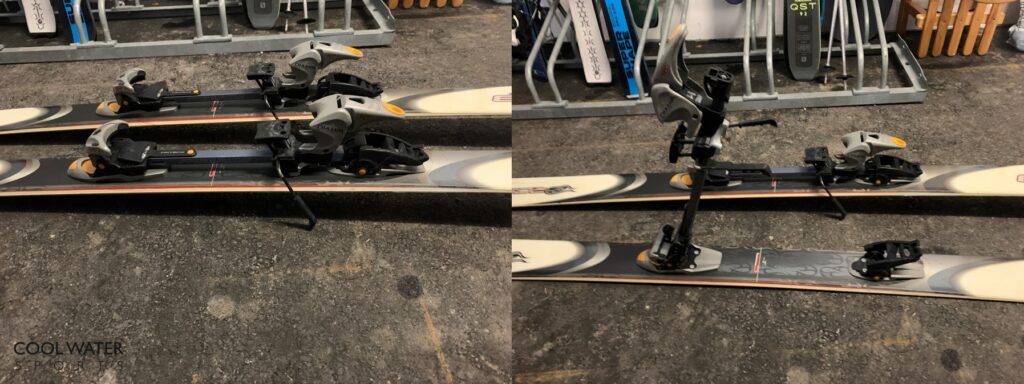
Secondly, while these skis are wide, they are optimized in terms of weight. This makes the ascent much simpler and more pleasant. However, it reduces the performance of the ski on descents, on the slopes, and in deep snow.
And thirdly, for backcountry and touring skiing, you need additional equipment such as ski skins, crampons, and telescopic poles.
Ski Mountaineering
If you thought backcountry skiing would be the end of it, think again. While most skiers – even the more adventurous ones – are perfectly content to attempt a hike in order to reach the perfect slope, there are a few less sane individuals who like to take it a step further. Maybe two.
Ski mountaineering lives up to its name. A large portion of the trip is dedicated to climbing and hiking. To this end, you’ll need to bring along plenty of spelunking gear in addition to your skis.
This sort of skiing should never be attempted alone. You’ll need to make use of a guide and bring along some of your best, most experienced skiing partners.
Freestyle
Freestyle skiing is pretty much exactly what it sounds like. It incorporates elements of all off-piste skiing styles but places particular emphasis on performing tricks.
Freestyle skiers can often seem more akin to video game characters than to normal humans, but rest assured that they’re just like you or me – only far more impressive. There are two main freestyle disciplines.
Slopestyle – Slopestyle skiing involves performing tricks on slopes, typically small kickers or bumps and grinding on rails. Of course, more advanced skiers can pull off bigger, more impressive kicks.
Big Air – Big air skiing is all about the jump and catching as much air as possible. Expect to see plenty of big kicks, vaults, and jumps.
Because of the risk involved with freestyle skiing, skiers must practice in designated safe areas. Even then, a few broken limbs are not uncommon. Before you attempt freestyle skiing for yourself, make sure that you’re already fluent in the fundamentals of skiing first.
Nordic Skiing: either cardio or style
Nordic skiing has its roots in northern Europe, though it’s probably safe to say that not many vikings practiced it. There are mainly two main types of Nordic Skiing: Cross-Country and Telemark. Telemark doesn’t differ from normal skiing in the sense that it is done downhill, but Cross-Country involves plenty of walking uphill.
However, thanks to the nature of Cross-Country skis, traveling across flat surfaces and uphill is much easier. What both Telemark and Cross-Country have in common is that the skis are only attached to the toes of the boots, allowing the heels to rise.
But now let’s have a deeper look.
Telemark Skiing
Most of the skiing styles we’ve discussed are largely determined by the terrain they’re used to navigate. However, Telemark skiing is better defined by the techniques it involves and the equipment required to pull it off.
On the technical side, you’ll have to get acquainted with the trademark Telemark turn. This involves moving the downhill ski ahead of the uphill ski while the uphill knee bends almost to ground level in order to complete a turn. This requires a considerable amount of strength, stamina, and discipline in order to master.
A good telemarker can then apply this technique to all different types of skiing, i.e. both on prepared slopes and in deep snow, and master the slope in style.
Cross-Country
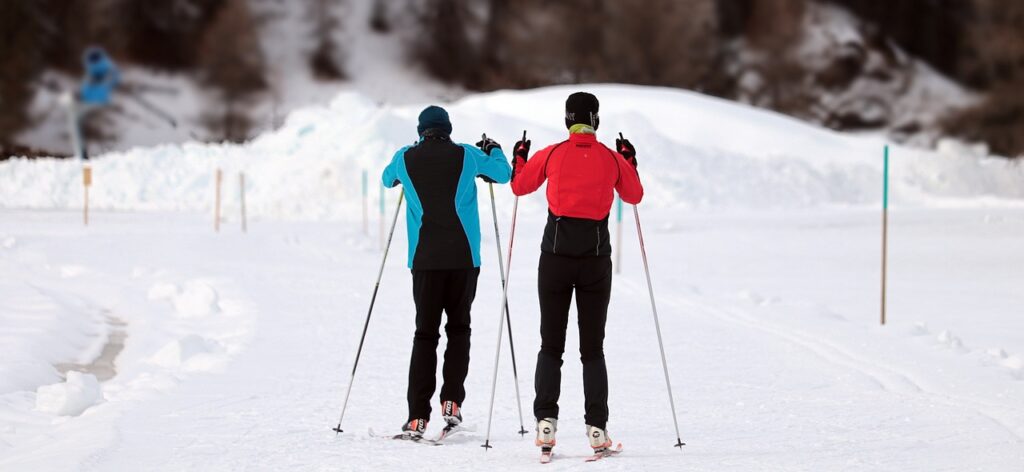
Cross-country skiing is the antithesis of everything the average person knows about skiing. Rather than traveling downhill, cross-country skiing involves navigating relatively even, flat stretches of terrain. Think of it as taking a nice, leisurely jog with skis.
Because of the difference in terrain, cross-country skis are shaped differently from normal downhill skis. While the latter are typically wide and heavy, cross-country skis are long and thin and do not have metal edges.
Another key distinction is the greater emphasis on poles. Because you’ll mostly be moving across flat, even surfaces, long poles are essential for propelling you forward. In fact, the poles used in cross-country skiing are long enough to propel you forward a long distance with one stroke.
Within Cross-country skiing you differentiate between two techniques: classic skiing and skate skiing.
Classic Skiing – This technique allows skiers to keep their skis parallel. They propel themselves by sliding their skis forward and backward.
Skate Skiing – Skate skiing requires shorter skis that allow the skier to kick sideways in order to propel themselves forward. However, a large part of the propulsion also comes from stick use.
In either case, because cross-country skiing requires more physical effort, it’s a perfect way to improve your fitness. Cross-country skiing is less about speed and more about enjoying the journey.
Conclusion
Whether you’re an avid skier with years of experience under your belt or a complete novice who’s just received his first pair of Slaloms, knowing the different styles of skiing allows you to develop your technique and really hone your skills.
You don’t need to be a racing enthusiast or a freeriding master to appreciate the different techniques on display. Hopefully, this article has shed some light on the many styles of skiing and provided you with a broader appreciation for this developing sport.






